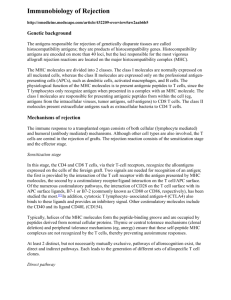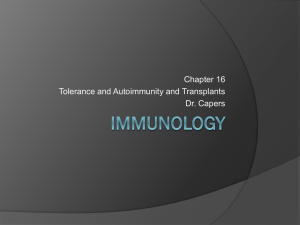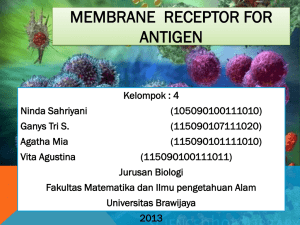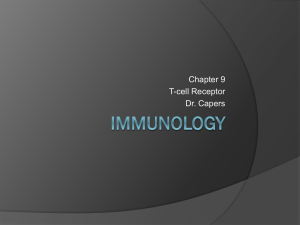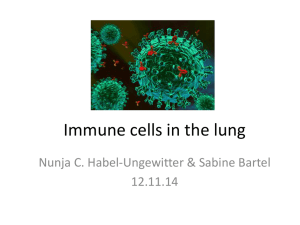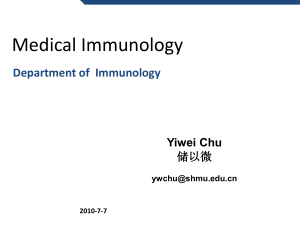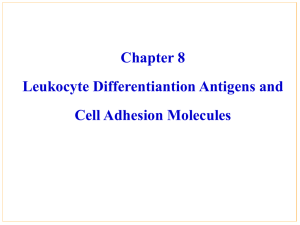Immunogens, Antigens, and Haptens Initiation of immune response
advertisement
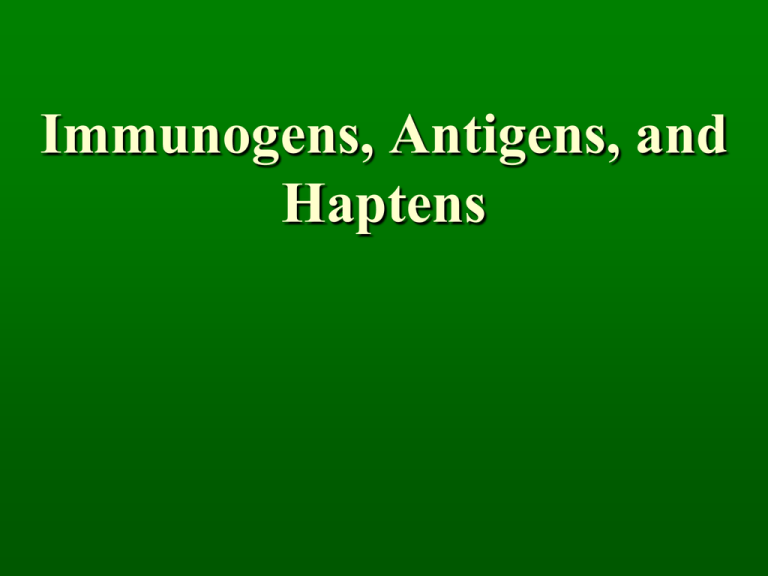
Immunogens, Antigens, and Haptens Initiation of immune response Interaction between receptor and ligand Affinity Avidity Affinity: high low strong binding low strong binding weak binding Introduction Immune responses arise as a result of exposure to foreign stimuli The compound that evokes an immune response is referred to as “antigen” or “immunogen.” The distinction between the two is functional but they are commonly used as synonyms. Definitions An immunogen is any substance capable of inducing an immune response An antigen is any substance capable of binding specifically to the products of the immune response All immunogens are antigens but not all antigens need be immunogens Special Types of Antigens Allergen Mitogen Super antigen Tolerogen According to source of antigen: - Xenoantigen - Heteroantigen - Alloantigen - Autoantigen Haptens are low molecular weight compounds (antibiotics and drugs) that by themselves are incapable of inducing an immune response, but they can react with its products When haptens are coupled with large molecules such as proteins (carriers), the resultant conjugate induces an immune response directed against the hapten and the carrier Factors influencing immunogenicity Factors Contribution of immunogen Contribution of biological system Method of administration Contribution of the immunogen Foreignness High Molecular Weight - <1000 Daltons : nonimmunogenic - 1000-6000 Daltons: may be immunogenic - > 6000 immunogenic Chemical Nature and Complexity - Homopolymers Vs Heteropolymers - Primary, secondary, tertiary, and quaternary structures Antigenic Determinants or Epitopes - Linear - Discontinuous Paratope: “The site in the variable (V) domain of an antibody or T-cell receptor that binds to an epitope on an antigen Physical Form Particulate > Soluble Denatured > Native Degradability Ag processing by Ag Presenting Cells (APC) Factors Influencing Immunogenicity Contribution of the Biological System Genetics Species Individual Responders vs. Non-responders Age Factors Influencing Immunogenicity Method of Administration Dose Route Subcutaneous > Intravenous > Intragastric Rate of elimination Adjuvant Substances that enhance an immune response to an Ag Adjuvants Substances which when mixed with an immunogen enhance the immune response against the immunogen They differ from carriers as they do not enhance immunity to haptens Release immunogens slowly but continuously Types: Freund’s incomplete or complete adjuvants, BCG, Corynebacterium parvum, Bordetella pertussis, LPS, and Alum precipitate (most widely used ) Major Classes of Immunogens Proteins: Best immunogens Carbohydrates: Usually but not always good immunogens Nucleic Acids: Poor immunogens by themselves unless coupled to carriers Lipids: Non immunogens unless coupled to carriers Cross Reactivity Modification of a molecule; toxins and toxoids Sharing epitopes between unrelated macromolecules Structural resemblance (molecular mimicry) Significance in - tolerance and autoimmunity - Isohemagglutinins Antigens: T-independent Activate B cells without MHC class II T help Polysaccharides Properties Polymeric structure Polyclonal B cell activation, but poor memory Resistance to degradation Examples Pneumococcal polysaccharide, LPS Flagella Antigens: T-dependent Require T help to activate B cells Proteins Structure Examples Microbial proteins Non-self or altered-self proteins Hapten-carrier conjugates Definition Ag only if bound to carrier protein Structure Native determinants Haptenic determinants Sequential (or linear) determinants Epitopes formed by several adjacent amino acid residues are called linear determinants. They exist on the surface of antigen molecules or inside of antigen molecules. They are mainly recognized by T cells, but some can also be recognized by B cells. Conformational determinants Conformational determinants are formed by amino acid residues that are not in a sequence but become spatially juxtaposed in the folded protein. They normally exist on the surface of antigen molecules. They are recognized by B cells or antibody. Antigenic Determinants Recognized by B cells and Ab Composition Proteins, polysaccharides, nucleic acids Sequence (linear) determinants Conformational determinants Size 4-8 residues Antigenic Determinants Recognized by B cells and Ab Composition Size Number Limited (immunodominant epitopes) Located on the external surfaces of the Ag Antigenic Determinants Recognized by T cells Composition Proteins (some lipids) Sequence determinants Size Processed MHC presentation (lipid presentation by MHC-like CD1) 8 -15 residues Number Limited to those that can bind to MHC Superantigens T cell T cell TCR TCR Super Ag Ag MHC MHC APC APC Definition Polyclonal T cell response Examples Staphylococcal enterotoxins Toxic shock toxin Superantigens Definition Conventional Antigen Monoclonal/ Oligoclonal T cell response 1:104 - 1:105 Superantigen Polyclonal T cell response 1:4 - 1:10 Most Important Human Antigens Membrane molecules of immune cells Receptors: TCR, BCR, CR, CKR, FcR Class I and class Ⅱ MHC molecules CD molecules: CD1~339 Cell Adhesion Molecules Cytokine Receptors Blood Group Antigens Pathogen recognition by adaptive immunity: great variety, selectivity T Lymphocytes • Distinguishing cell-surface markers include TCR, CD3, CD2, CD4 or CD8, CD28, and CD45 • Similarities between T and B cells: • Antigen receptor on surface (TCR) • Recognize single, specific antigen • Expand through clonal selection • Some T cells exist as long-lived memory cells B Lymphocytes • Recognize antigen by means of surface-expressed antigen receptor • Distinguishing cell-surface markers include: B220 (CD45), MHC Class II, CD80 (B7-1) and CD86 (B7-2), CD40, CD19, CD21, etc. Bursa of fabricius Figure 3-13 part 1 of 2 The peptide-binding groove of MHC molecules Figure 3-15 Present Ag to CD8 T cells Present Ag to CD4 T cells Polymorphism: presence of multiple alternative forms (alleles) of a gene. Help peptide loading Present antigen peptides to CD4+ T cells Polymorphism allows the population to handle a variety of pathogens. Different cell distribution of MHC class I and II Figure •3-22 Almost all cells express MHC I for comprehensive surveillance by CD8 T cells • Only some cells express high levels of MHC II and MHC I • These are B cells, macrophages, dendritic cells and thymic epithelial cells. • B cells, macrophages and dendritic cells are called professional antigenpresenting cells (APC). • IFN-g increases the expression of MHC II in APC and induces the expression in non-APC cells at sites of infection Leukocyte Differentiation Antigens and CD Leukocyte differentiation antigen: Cell surface molecules expressed (or disappeared) during different developmental and differential phases, activation or inactivation process of blood cells. Identifying Cell Using the CD Nomenclature CD Cluster Of Differentiation Over 300 CD Markers T cells, CD4 or CD8 and CD3 B cells, CD19 NK cells, CD56 Monocytes /Macrophages CD14 Dendritic Cells, CD1c CD - Cluster of Differentiation Table 2-4 CDs which take part in T cell recognition, adhesion and activation CDs which take part in B cell recognition, adhesion and activation Adhesion Molecules Cell adhesion molecules (CAMs) are cell surface proteins involved in the interaction of cell-cell or cell-extracellular matrix. CAMs take effect by the binding of receptor and ligand. Ⅱ. Classification Integrin family Selectin family Immunoglobulin (Ig) superfamily Cadherin family Mucin - like family Other adhesion molecules 1. Integrin family Integrins consist of α and β chains. According to β subunits, Integrins are divided into eight groups: β1- β8 VLA-4(Very Late Antigen-4)------VCAM-1 LFA-1(Lymphocyte Function-associated Antigen-1) ICAM-1,2,3 MAdCAM-1 (Mucosal Addressin Cell Adhesion Molecule-1) TSP-1 ((Thrombospondin一1) 2. Selectin family Selectins consist of one peptide chain. The three family members include: E- selectin, L-selectin, and P-selectin. 3. Ig superfamily(IgSF) The structure of these adhesion molecules resemble that of Ig. CD4, CD8, CD2(LFA-2), CD58(LFA-3), VCAM-1, ICAM-1,2,3 4. Cadherin family E- cadherin------ Epithelia cell N- cadherin------ Nerve cell P- cadherin-------Placenta 5. Mucin -like family CD34, GlyCAM-1(glycosylation dependent cell adhesion molecule-1) PSGL-1(P-selectin glycoprotein ligand-1) 6. Other adhesion molecules CD44 Ⅲ. Functions 1. Participate in development and differentiation of immune cells CD2----LFA-3 LFA-1----ICAM-1 Participate in development and maturation of thymocytes. 2. Participate in immune response and regulation IL-21 IL-10 Cytokine Receptor Families TLRs

